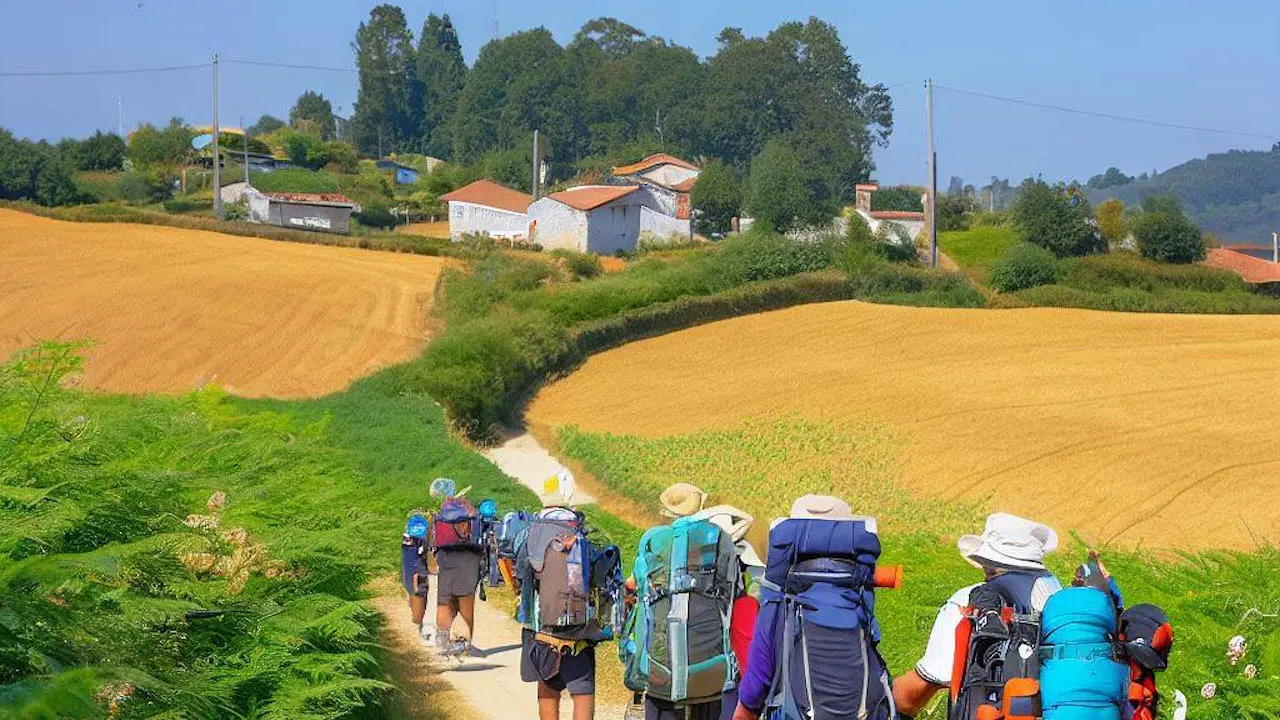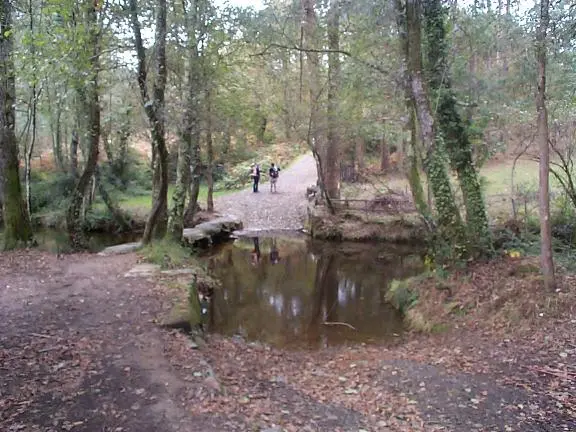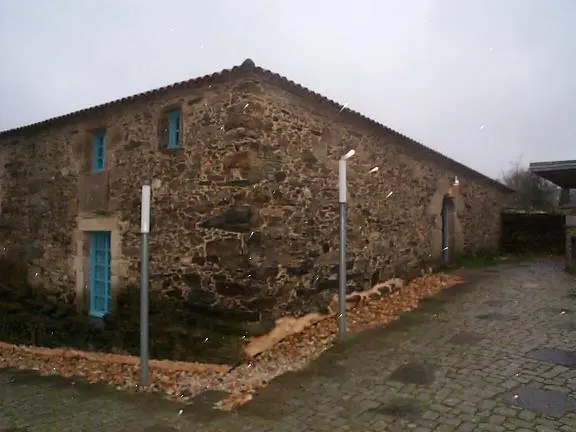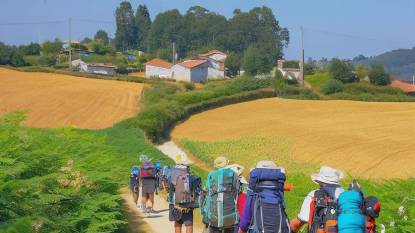
Camino Francés: Palas De Rei to Ribadiso De Baixo - Stage 24
Posted: | Updated:Reading time: 7 minutes
Camino Francés: Palas De Rei to Ribadiso De Baixo - Stage 24
Posted: | Updated:Reading time: 7 minutes
By: Simon Kemp, Editor
The stage from Palas de Rei to Ribadiso da Baixo, covering 25.8 km (16 miles), involves a journey through small hamlets and diverse landscapes, leading to the town of Melide where the Camino Francés meets the Camino Primitivo.
Departing Melide, the route includes a series of picturesque villages and woodland paths, concluding in the serene hamlet of Ribadiso da Baixo by the Iso River. Despite the length, the stage is fairly moderate in terms of elevation changes.
Route Description: Palas De Rei to Ribadiso De Baixo
A. Detailed Breakdown of the Route
- Palas de Rei to Melide (14.6 km) Leaving the town of Palas de Rei, you’ll embark on a journey through small hamlets steeped in Galician culture and a variety of landscapes, including forest paths and agricultural fields. As you progress, you’ll reach San Xulián do Camiño, a typical rural hamlet. Continuing, the pathway leads to the significant town of Melide, well-known for its octopus dish, ‘pulpo a la gallega’. Here, the Camino Francés meets with the Camino Primitivo.
- Melide to Ribadiso da Baixo (11.2 km) Departing Melide, the Camino goes through a series of picturesque villages and beautiful woodland paths. Highlights include crossing several medieval bridges like the Ponte das Pías and the Ponte Furelos. The stage concludes in the picturesque hamlet of Ribadiso da Baixo, nestled by the Iso River.
B. Terrain and Elevation
The majority of this stage involves woodland trails and rural paths, providing a peaceful walking experience. The stage has a couple of minor ascents and descents but nothing overly strenuous, making it a relatively moderate stage for most pilgrims.
C. Points of Interest
- Melide: A significant stop on the Camino for its culinary heritage, especially its famous octopus dish ‘pulpo a la gallega’. Melide also offers historical attractions like the Church of Santa María and the Ethnographic Museum Terra de Melide.
D. Potential Challenges
While the stage from Palas de Rei to Ribadiso da Baixo is not particularly difficult in terms of elevation changes, it covers a relatively long distance (25.8 km). Pilgrims should pace themselves, maintain proper hydration, and take breaks when necessary.
E. Rest Stops
Melide, located roughly halfway, serves as a significant rest stop. Here, pilgrims can find a variety of eateries, including those serving the famous ‘pulpo a la gallega’, and accommodations for resting. Ribadiso da Baixo, while small, provides facilities for pilgrims to rest and refresh, offering a tranquil setting by the river.
Camino Route Map Palas de Rei to Ribadiso
Departure point: Palas de Rei
Embarking on the Camino Francés pilgrimage takes you on an extraordinary journey across Spain’s picturesque landscapes and captivating towns. Among these, Palas De Rei, nestled in the province of Lugo, holds a distinctive place with its historical allure and warm-hearted community.
Historical Significance
Palas De Rei is a town that has gracefully aged with time, narrating tales of its rich past that dates back to the Roman era. It’s a true historical feast for those who relish the past. The iconic Church of San Tirso, with its awe-inspiring Romanesque architectural style, is a cherished stop for every pilgrim in town.
The Journey through Palas De Rei
As you tread from Portomarin to Palas De Rei, the journey gifts you unforgettable moments. You pass through verdant hills, charming old farmsteads, and woodlands infused with the fragrance of eucalyptus. This serene and rejuvenating passage mirrors the spiritual essence of the Camino walk.
Accommodation Options
The town of Palas De Rei presents a range of accommodation options to suit every pocket. From cozy albergues offering shared dormitory-like spaces to comfortable hotels and rustic houses, you’ll find an array of choices. The commendable hospitality of Palas De Rei’s locals is heartwarming, as they go the extra mile to make every visitor feel at home.
Gastronomy
The Camino Francés walk is not just a feast for the eyes, but also a gastronomic delight. The local Galician cuisine of Palas De Rei tempts every palate with traditional delicacies such as ‘pulpo a la gallega’ (octopus in Galician style) and ’empanada gallega’ (a Galician pie). Also, don’t miss the town’s renowned local cheese, ‘queso de tetilla.’
Activities in Palas De Rei
Beyond the walk of Camino, Palas De Rei has much to offer. Whether you fancy a leisurely wander around the town, wish to explore the local markets, or partake in local festivals, there’s something for everyone. The town is lively and vibrant, offering ample opportunities for cultural immersion.
Preparation Tips
While preparing for your journey through Palas De Rei, it’s essential to pack clothing suitable for the variable weather conditions. Sturdy footwear is also critical, considering the terrain comprises paved roads, dirt trails, and occasional rough spots. Being well-prepared allows you to fully enjoy this part of the Camino journey.
Palas De Rei Specific Camino Services
In Palas De Rei, the services available to the Camino pilgrims stand out. With a dedicated Pilgrim’s Reception Centre, luggage transfer facilities, wellness centers for rejuvenating massages, a reliable postal service, and stores selling Camino-specific items, Palas De Rei serves as a comprehensive support hub for pilgrims.
Camino Francés Diary: Route segment: 24
Sunday 29th October 2000


Destination: Ribadiso De Baixo
Among the Camino Francés route’s many stops, Ribadiso De Baixo holds a special place. This peaceful hamlet, nestled in Galicia, Spain, is known for its serene setting and welcoming atmosphere.
Historical Significance
While there may not be grand monuments or notable architectural feats in Ribadiso De Baixo, the town’s simplicity and antiquity tell a tale of its own. It’s a spot that has given respite to numerous pilgrims over centuries, making it a meaningful part of the Camino Francés journey.
Pilgrim Services
Despite its modest size, Ribadiso De Baixo is equipped to cater to the pilgrims’ needs. The town is home to the Albergue de Ribadiso, one of the most cherished hostels along the Camino Francés route. Operated by Xunta de Galicia, this albergue is an ideal spot for pilgrims to rest, replenish, and exchange stories.
In its simplicity and tranquillity, Ribadiso De Baixo offers a much-needed break to the Camino Francés pilgrims. This small but hospitable town serves as a gentle reminder that sometimes, the most humble places leave the deepest impressions. It is worth noting that most pilgrims end their journey at Arzua for this stage of the Camino Francés.
Historic Sites along this Section
There are several historical sites along the route from Palas de Rei to Ribadiso de Baixo. Here are some of them:
- Palas de Rei: This town has a distinctive place with its historical allure and warm-hearted community. There is the Church of San Tirso which has a Romanesque portal and scallop shells decorate a medieval building.
- San Xulián do Camiño: This village has historic links with Saint Julian. There is a small Romanesque Parish Church San Julian do Camino which illustrates the devotion to the saint in this area.
- Melide: A significant stop on the Camino for its culinary heritage, especially its famous octopus dish ‘pulpo a la gallega’. Melide also offers historical attractions like the Church of Santa María and the Ethnographic Museum Terra de Melide.
These sites provide a glimpse into the rich history and culture of the region. Enjoy your journey!
Public Transportation
Although this part of the Camino Francés pilgrimage covers only 25.8 km (16 miles) through hamlets and forests, you may need to travel by public transportation instead. Here are some options:
Bus
You can take the MonBus service from Palas de Rei to Rivadiso, which is close to Ribadiso de Baixo. The bus runs four times a day and takes about 28 minutes. The ticket costs €2 – €3. You can see the bus schedule and book online at MonBus.
Taxi
You can also take a taxi from Palas de Rei to Ribadiso de Baixo, which takes about 23 minutes and covers 26.6 km. The fare is around €30 – €45. You can find taxi services in Palas de Rei at Taxi Palas or Taxi Lugo.
Car
If you have your own car or rent one, you can drive from Palas de Rei to Ribadiso de Baixo, following the LU-633 road. The journey takes about 23 minutes and costs €4 – €7 in fuel. You can find car rental options in Palas de Rei at Car Rental Palas or Car Rental Lugo.
